#gavin finney interview interview
Explore tagged Tumblr posts
Text
Oooh! A great Gavin Finney (Good Omens Director of Photography) interview with Helen Parkinson for the British Cinematographer! :)
HEAVEN SENT
Gifted a vast creative landscape from two of fantasy’s foremost authors to play with, Gavin Finney BSC reveals how he crafted the otherworldly visuals for Good Omens 2.
It started with a letter from beyond the grave. Following fantasy maestro Sir Terry Pratchett’s untimely death in 2015, Neil Gaiman decided he wouldn’t adapt their co-authored 1990 novel, Good Omens, without his collaborator. That was, until he was presented with a posthumous missive from Pratchett asking him to do just that.
For Gaiman, it was a request that proved impossible to decline: he brought Good Omens season one to the screen in 2019, a careful homage to its source material. His writing, complemented by some inspired casting – David Tennant plays the irrepressible demon Crowley, alongside Michael Sheen as angel-slash-bookseller Aziraphale – and award-nominated visuals from Gavin Finney BSC, proved a potent combination for Prime Video viewers.
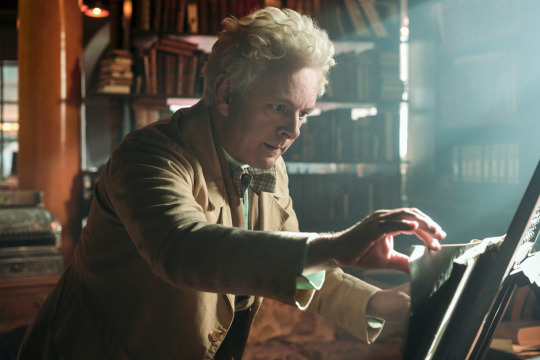
Aziraphale’s bookshop was a set design triumph.
Season two departs from the faithful literary adaptation of its predecessor, instead imagining what comes next for Crowley and Aziraphale. Its storyline is built off a conversation that Pratchett and Gaiman shared during a jetlagged stay in Seattle for the 1989 World Fantasy Convention. Gaiman remembers: “The idea was always that we would tell the story that Terry and I came up with in 1989 in Seattle, but that we would do that in our own time and in our own way. So, once Good Omens (S1) was done, all I knew was that I really, really wanted to tell the rest of the story.”
Telling that story visually may sound daunting, but cinematographer Finney is no stranger to the wonderfully idiosyncratic world of Pratchett and co. As well as lensing Good Omens’ first outing, he’s also shot three other Pratchett stories – TV mini series Hogfather (2006), and TV mini-series The Colour of Magic (2008) and Going Postal (2010).
He relishes how the authors provide a vast creative landscape for him to riff off. “The great thing about Pratchett and Gaiman is that there’s no limit to what you can do creatively – everything is up for grabs,” he muses. “When we did the first Pratchett films and the first Good Omens, you couldn’t start by saying, ‘Okay, what should this look like?’, because nothing looks like Pratchett’s world. So, you’re starting from scratch, with no references, and that starting point can be anything you want it to be.”
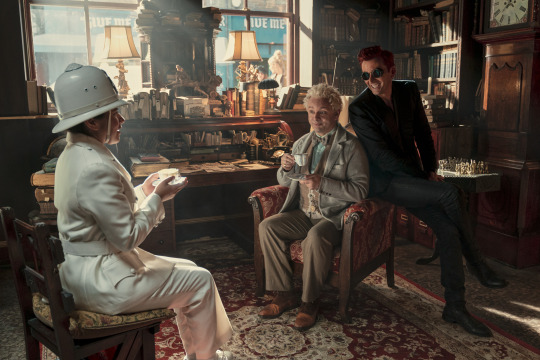
Season two saw the introduction of inside-outside sets for key locations including Aziraphale’s bookshop.
From start to finish
The sole DP on the six-episode season, Finney was pleased to team up again with returning director Douglas Mackinnon for the “immensely complicated” shoot, and the pair began eight weeks of prep in summer 2021. A big change was the production shifting the main soho set from Bovington airfield, near London, up to Edinburgh’s Pyramids Studio. Much of the action in Good Omens takes place on the Soho street that’s home to Aziraphale’s bookshop, which was built as an exterior set on the former airfield for season one. Season two, however, saw the introduction of inside-outside sets for key locations including the bookshop, record store and pub, to minimise reliance on green screen.
Finney brought over many elements of his season one lensing, especially Mackinnon’s emphasis on keeping the camera moving, which involved lots of prep and testing. “We had a full-time Scorpio 45’ for the whole shoot (run by key grip Tim Critchell and his team), two Steadicam operators (A camera – Ed Clark and B camera Martin Newstead) all the way through, and in any one day we’d often go from Steadicam, to crane, to dolly and back again,” he says. “The camera is moving all the time, but it’s always driven by the story.”
One key difference for season two, however, was the move to large-format visuals. Finney tested three large-format cameras and the winner was the Alexa LF (assisted by the Mini LF where conditions required), thanks to its look and flexibility.

The minisodes were shot on Cooke anamorphics, giving Finney the ideal balance of anamorphic-style glares and characteristics without too much veiling flare.
A more complex decision was finding the right lenses for the job. “You hear about all these whizzy new lenses that are re-barrelled ancient Russian glass, but I needed at least two full sets for the main unit, then another set for the second unit, then maybe another set again for the VFX unit,” Finney explains. “If you only have one set of this exotic glass, it’s no good for the show.”
He tested a vast array of lenses before settling on Zeiss Supremes, supplied by rental house Media Dog. These ticked all the boxes for the project: “They had a really nice look – they’re a modern design but not over sharp, which can look a bit electronic and a bit much, especially with faces. When you’re dealing with a lot of wigs and prosthetics, we didn’t want to go that sharp. The Supremes had a very nice colour palette and nice roll-off. They’re also much smaller than a lot of large-format glass, so that made it easy for Steadicam and remote cranes. They also provided additional metadata, which was very useful for the VFX department (VFX services were provided by Milk VFX).”
The Supremes were paired with a selection of filters to characterise the show’s varied locations and characters. For example, Tiffen Bronze Glimmerglass were paired with bookshop scenes; Black Pro-Mist was used for Hell; and Black Diffusion FX for Crowley’s present-day storyline.
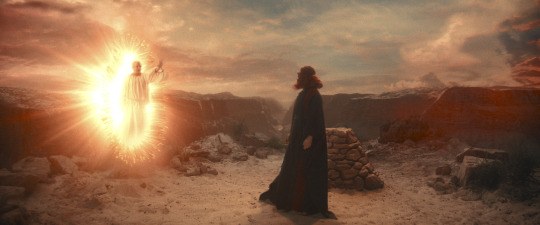
Finney worked closely with the show’s DIT, Donald MacSween, and colourist, Gareth Spensley, to develop the look for the minisode.
Maximising minisodes
Episodes two, three and four of season two each contain a ‘minisode’ – an extended flashback set in Biblical times, 1820s Edinburgh and wartime London respectively. “Douglas wanted the minisodes to have very strong identities and look as different from the present day as possible, so we’d instantly know we were in a minisode and not the present day,” Finney explains.
One way to shape their distinctive look was through using Cooke anamorphic lenses. As Finney notes: “The Cookes had the right balance of controllable, anamorphic-style flares and characteristics without having so much veiling flare that they would be hard to use on green screens. They just struck the right balance of aesthetics, VFX requirements and availability.” The show adopted the anamorphic aspect ratio (2:39.1), an unusual move for a comedy, but one which offered them more interesting framing opportunities.
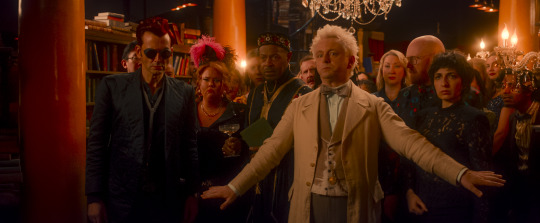
Good Omens 2 was shot on the Alexa LF, paired with Zeiss Supremes for the present-day scenes.
The minisodes were also given various levels of film grain to set them apart from the present-day scenes. Finney first experimented with this with the show’s DIT Donald MacSween using the DaVinci Resolve plugin FilmConvert. Taking that as a starting point, the show’s colourist, Company 3’s Gareth Spensley, then crafted his own film emulation inspired by two-strip Technicolor. “There was a lot of testing in the grade to find the look for these minisodes, with different amounts of grain and different types of either Technicolor three-strip or two-strip,” Finney recalls. “Then we’d add grain and film weave on that, then on top we added film flares. In the Biblical scenes we added more dust and motes in the air.”
Establishing the show’s lighting was a key part of Finney’s testing process, working closely with gaffer Scott Napier and drawing upon PKE Lighting’s inventory. Good Omens’ new Scottish location posed an initial challenge: as the studio was in an old warehouse rather than being purpose-built for filming, its ceilings weren’t as high as one would normally expect. This meant Finney and Napier had to work out a low-profile way of putting in a lot of fixtures.
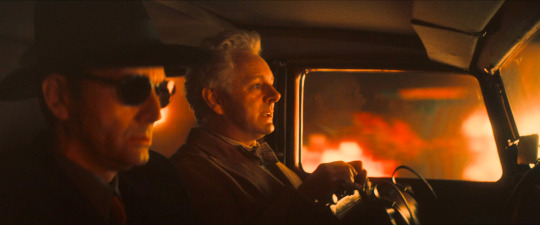
Inside Crowley’s treasured Bentley.
Their first task was to test various textiles, LED wash lights and different weight loadings, to establish what they were working with for the street exteriors. “We worked out that what was needed were 12 SkyPanels per 20’x20’ silk, so each one was a block of 20’x20’, then we scaled that up,” Finney recalls. “I wanted a very seamless sky, so I used full grid cloth which made it very, very smooth. That was important because we’ve got lots of cars constantly driving around the set and the sloped windscreens reflect the ceiling. So we had to have seamless textiles – PKE had to source around 12,000 feet of textiles so that we could put them together, so the reflections in the windscreens of the cars just showed white gridcloth rather than lots of stage lights. We then drove the car around the set to test it from different angles.”
On the floor, they mostly worked with LEDs, providing huge energy and cost savings for the production. Astera’s Titan Tubes came in handy for a fun flashback scene with John Hamm’s character Gabriel. The DP remembers: “[Gabriel] was travelling down a 30-foot feather tunnel. We built a feather tunnel on the stage and wrapped it in a ring of Astera tubes, which were then programmed by dimmer op Jon Towler to animate, pulse and change different colours. Each part of Gabriel’s journey through his consciousness has a different colour to it.”
Among the rigs built was a 20-strong Creamsource Vortex setup for the graveyard scene in the “Body Snatchers” minisode, shot in Stirling. “We took all the yokes off each light then put them on a custom-made aluminium rig so we could have them very close. We put them up on a big telehandler on a hill that gave me a soft mood light, which was very adjustable, windproof and rainproof.”
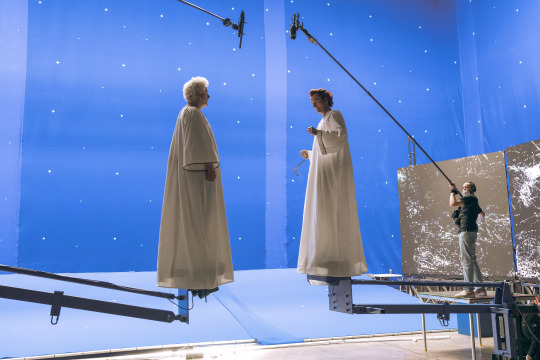
Shooting on the VP stage for the birth of the universe scenes in episode one.
Sky’s the limit
A lot of weather effects were done in camera – including lightning effects pulsed in that allowed both direct fork lightning and sheet lightning to spread down the streets. In the grade, colourist Spensley was also able to work his creative magic on the show’s skies. “Gareth is a very artistic colourist – he’s a genius at changing skies,” Finney says. “Often in the UK you get these very boring, flat skies, but he’s got a library of dramatic skies that you can drop in. That would usually be done by VFX, but he’s got the ability to do it in Baselight, so a flat sky suddenly becomes a glorious sunset.”
Finney emphasises that the grade is a very involved process for a series like Good Omens, especially with its VFX-heavy nature. “This means VFX sequences often need extra work when it comes back into the timeline,” says the DP. “So, we often add camera movement or camera shake to crank the image up a bit. Having a colourist like Gareth is central to a big show like Good Omens, to bring all the different visual elements together and to make it seamless. It’s quite a long grade process but it’s worth its weight in gold.”

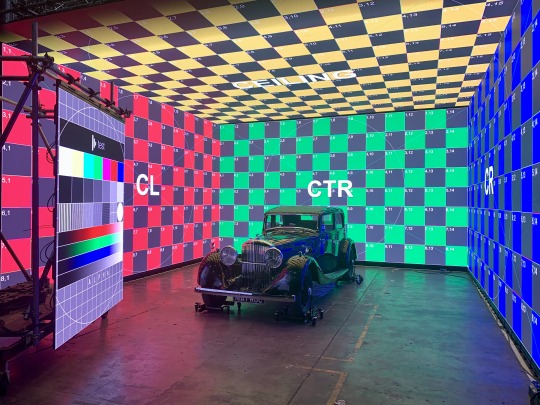

Shooting in the VR cube for the blitz scenes .
Finney took advantage of virtual production (VP) technology for the driving scenes in Crowley’s classic Bentley. The volume was built on their Scottish set: a 4x7m cube with a roof that could go up and down on motorised winches as needed. “We pulled the cars in and out on skates – they went up on little jacks, which you could then rotate and move the car around within the volume,” he explains. “We had two floating screens that we could move around to fill in and use as additional source lighting. Then we had generated plates – either CGI or real location plates –projected 360º around the car. Sometimes we used the volume in-camera but if we needed to do more work downstream; we’d use a green screen frustum.” Universal Pixels collaborated with Finney to supply in-camera VFX expertise, crew and technical equipment for the in-vehicle driving sequences and rear projection for the crucial car shots.

John Hamm was suspended in the middle of this lighting rig and superimposed into the feather tunnel.
Interestingly, while shooting at a VP stage in Leith, the team also used the volume as a huge, animated light source in its own right – a new technique for Finney. “We had the camera pointing away from [the volume] so the screen provided this massive, IMAX-sized light effect for the actors. We had a simple animation of the expanding universe projected onto the screen so the actors could actually see it, and it gave me the animated light back on the actors.”
Bringing such esteemed authors’ imaginations to the screen is no small task, but Finney was proud to helped bring Crowley and Aziraphale’s adventures to life once again. He adds: “What’s nice about Good Omens, especially when there’s so much bad news in the world, is that it’s a good news show. It’s a very funny show. It’s also about good and evil, love and doing the right thing, people getting together irrespective of backgrounds. It’s a hopeful message, and I think that that’s what we all need.”
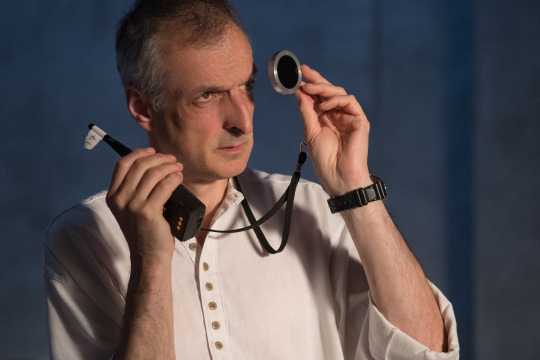
Finney is no stranger to the idiosyncratic world of Sir Terry Pratchett and Neil Gaiman.
#good omens#gos2#season 2#interview#gavin finney#neil gaiman#terry pratchett#gavin finney interview interview#s2 interview#bts#fun fact#british cinematographer#british cinematographer 2023#jon hamm#2ep1#2ep2#2ep3#2ep4#2ep6#2i1i1#job's minisode#1941 minisode#1827 minisode#2i6i7#bentley
2K notes
·
View notes
Text



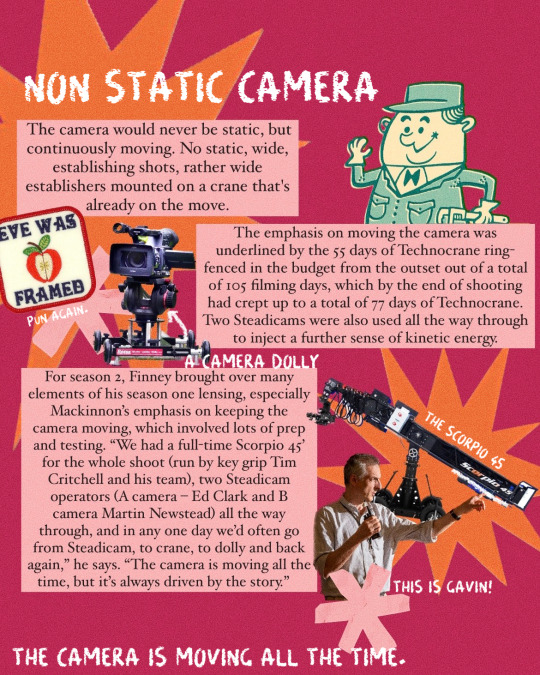



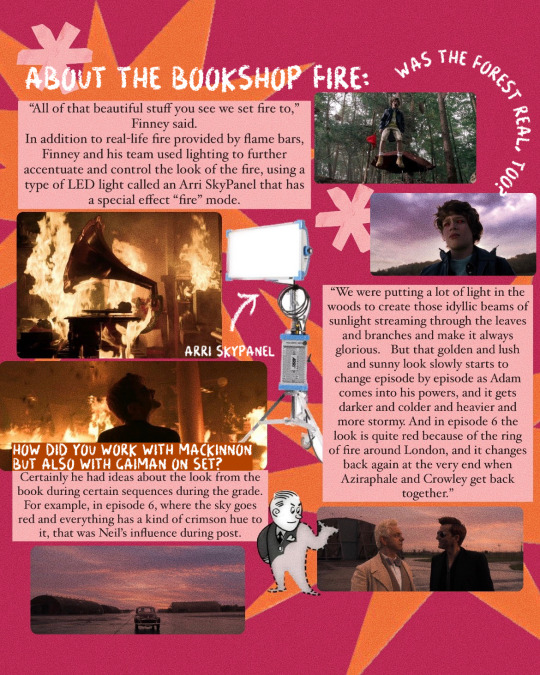

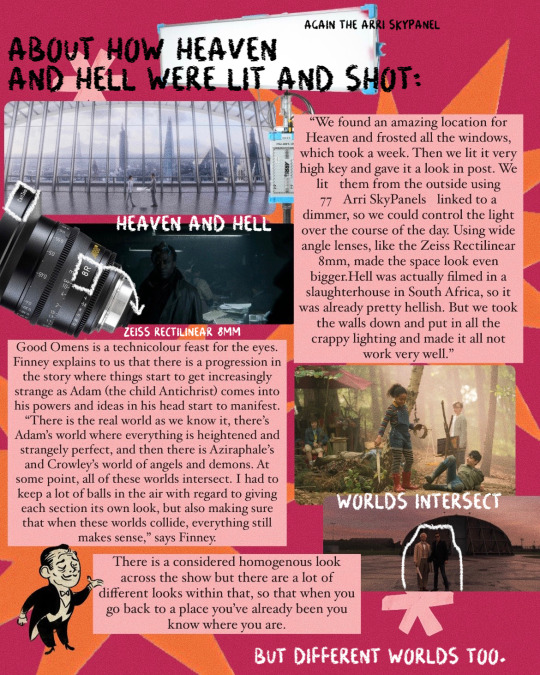
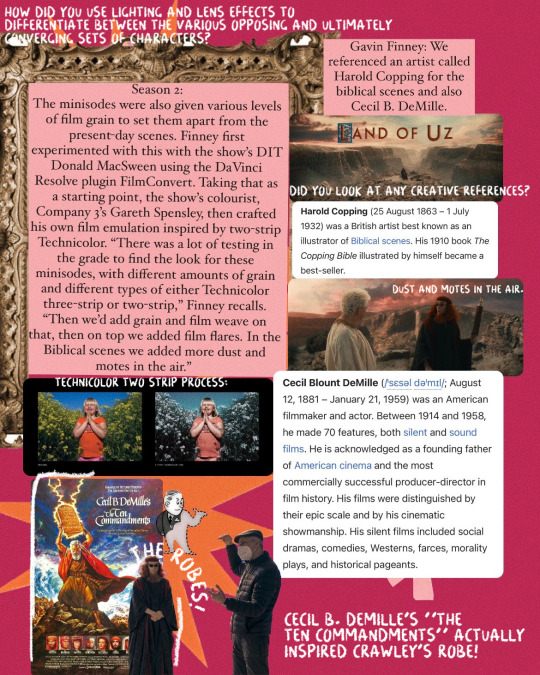


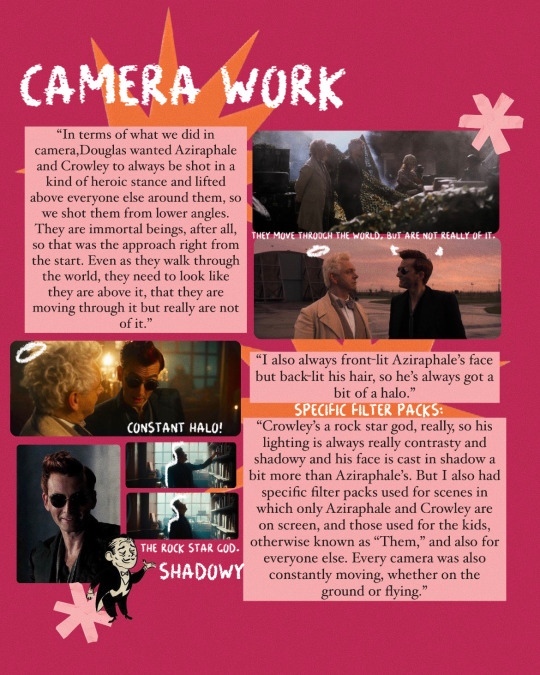
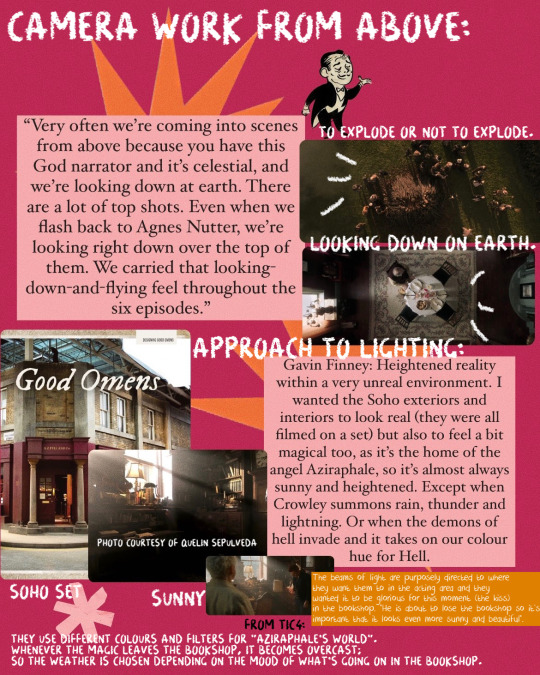
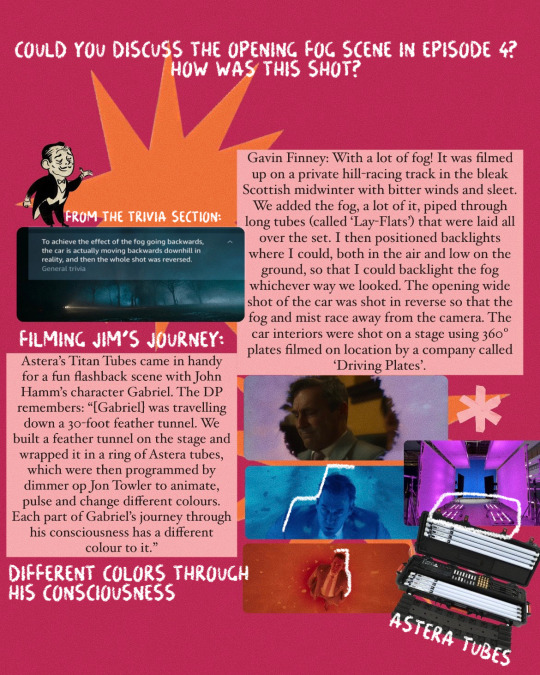
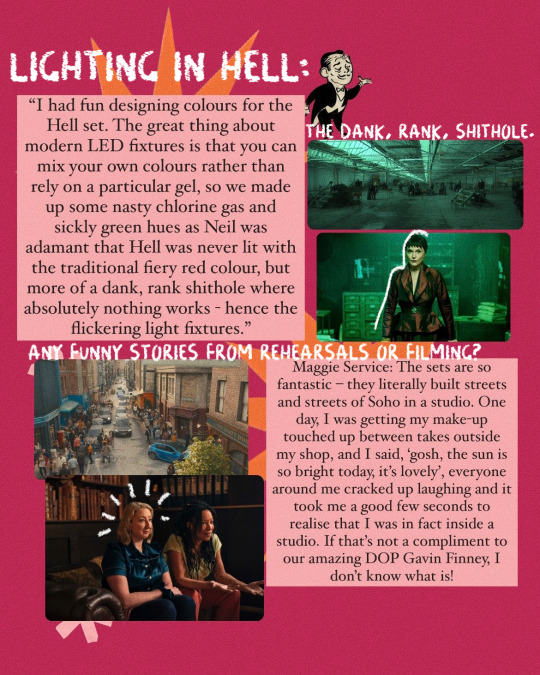
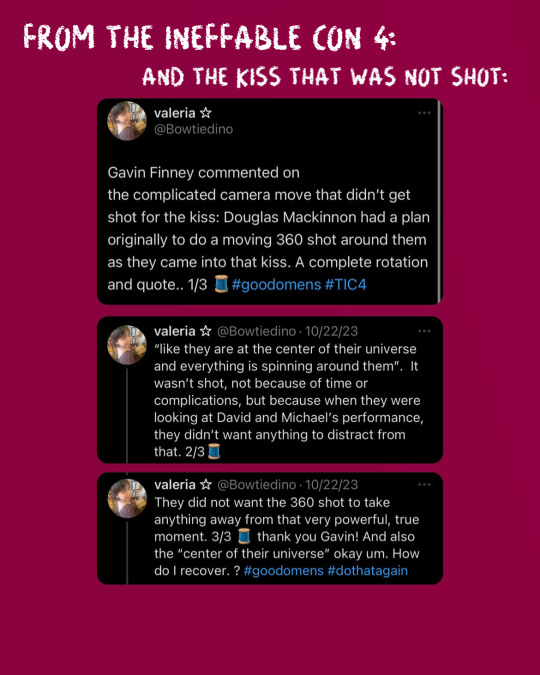
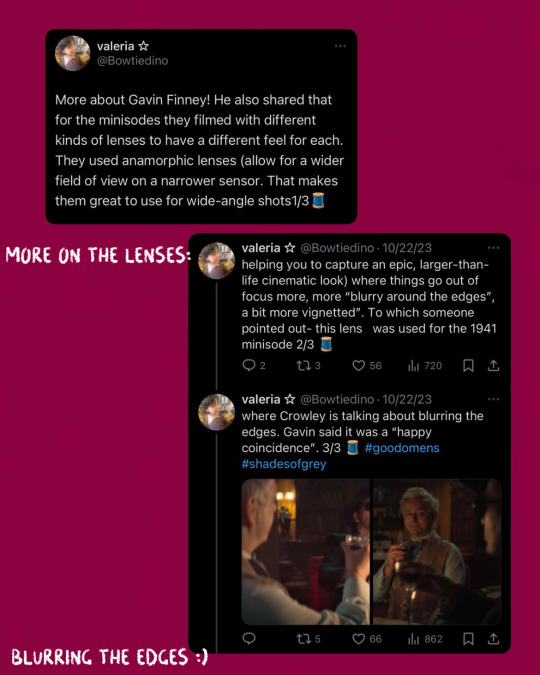
Good Omens: behind the camera!
With DoP Gavin Finney.
I gathered together all of the interviews I could find where Gavin Finney discusses his work for Good Omens: including how he framed certain shots, the filters used for some scenes, how Aziraphale has a constant halo and celestial shots. (Even a camera that only exists for filming the Gavotte).
There are even more things dealing with CGI and VFX in the articles. So do give them a read if you can!
I also added some things he mentioned for The Ineffable Con 4.
Here are all of my sources:
British Cinematographer Season 1
Good Omens DP Gavin Finney on Earthly and Otherwordly In-Camera Delights
British Cinematographer Season 2
How Cinematographer Gavin Finney Brought Heaven and Hell to Life in ‘Good Omens’
DP Chat: Good Omens cinematographer Gavin Finney
Definition Magazine: Raining Men, Omen
On Shooting Good Omens
Maggie Service: ‘The Good Omens Universe Is A Lovely Place To Inhabit’ – Interview
Tweets because I do now know how to call them anymore:
About the kiss.
Blurring the edges.
Intentional Lighting.
#good omens#aziraphale#crowley#ineffable husbands#neil gaiman#terry pratchett#good omens fun facts#good omens 2#easter eggs#gavin finney#cinematography#film stills#good omens behind the scenes
455 notes
·
View notes
Text
Whose POV is it anyway?
An Introduction
DO NOT ASK NEIL ABOUT FAN THEORY
Cracking down on the storytelling of Good Omens season 2 through the lens of a changing narrator.
If you haven't read this interview with Good Omens cinematographer Gavin Finney, and you're interested in the fantastic dedication and detail that went into this TV show, definitely give it a read. Not only is it lovely, but Neil also posted the article with a caption mentioning that it's got so many secrets in it. Obviously that made me take a closer look.
I have already gone into a fair bit of detail about the different Lens Filters that Finney mentions in the article in a separate post and I will be referring to them quite a bit so if you aren't familiar with them I would suggest reading that first!
This first post is going to cover the basics of changing narrator/POV's and I'll be writing additional posts for separate episodes/minisodes/scenes since there's obviously way too much to cover in a single go. So shall we take our first look?

It's no secret that something's a *bit weird* with season two, and there are SO many theories about it. I love to read speculation, metas, theories, and opinions, it's definitely fun but my personal ideas align more with the idea that we're simply being shown the events of season 2 through the memories of multiple narrators, different POV's, and it slightly skews the story, sometimes within one continuous scene.
I am also a sucker for a good multiple timeline theory but that isn't this post.
Lens Filters
As I stated above, I wrote a post about each of these individual filters earlier. What I didn't go into in that post was speculation about the filters. While I think they're pretty straightforward, especially the filter for hell (Black Pro-Mist ((BPM)), I think the other two have a bit more room for speculation.
Bronze Glimmer Glass
BGG was described by Finney as being used for 'bookshop scenes', but after S2 back numerous times and paying as much attention as I could to the lighting and colouring of the scenes, I think this is generally true but not always true. There are times when bookshop scenes seem to use a different filter, and other locations also seem to be shot with the BGG filter as well. I think BGG aligns with Aziraphale's POV. Or if Not Aziraphale, an outside-of-Crowley narrator? Based on the scenes (which we'll specifically get into in other posts) which BGG seems to be used, context clues, character behavior, etc, I think BGG clues us in that we're seeing, if you will, through Aziraphale's eyes.
Black Diffusion FX
BDFX was described as being used for 'Crowley's present day storyline' and fuck me, that's not ominous or weirdly phrased at all Mr. Finney! This filter definitely aligns with Crowley. Most of the time he's separate from Aziraphale it seems that this is the filter being used, and certain scenes switch filters mid-scene when he begins to go off on snarky Crowley-centric commentary.
Catch-22 & Herzog
The books on Gabriels bookshelf, great books obviously, but I think books that are also meant to give us context about the story. Pride and Prejudice is a love story about making snap judgements on someone's character, and coming to recognize somebody might be good despite their title or appearance. The Crow Road is a story about life, death, love, morality, mystery, and God. 1984 details the tragedy of Julia and Winston's attempt at falling in love while living under in a police state. You see my point?
That's why I wanted to touch a bit more on Catch-22 and Herzog specifically when talking about the possibility of changing narrators/POV's in Good Omens 2.
Catch-22 frequently switches narrator and the events described are often not necessarily sequential. This way you're getting information about previous scenes as the story continues, so while you're reading the book you're forming a more complete image of the events as the story continues from different characters POV's and iterations of the story. Sound relevant?
Herzog is the other book I wanted to talk about. To be fair I haven't read Herzog in full like I have Catch-22 but I pulled out my copy to reference and flip through a bit to remind myself. Herzog unlike Catch-22 doesn't switch narrators but the narration by the main character, Herzog himself, switches between first and third person throughout. When he is narrating through his letters, you get a deeper look at his thought processes and emotions. It also relies on flashbacks to bring context to the life of Herzog.
While these books touch on other elements that are relevant to the Good Omens story, namely Yossarian's relationship and views of God in Catch-22, the way these stories are told intrigued me for this context.
Crowley's Hair
Yeah I'm gonna mention the hair, because I think the hair is linked. Crowley's shorter sideburns, trimmed mutton chops in the 1827 flashback, and shorter Job wig seem to be clearly aligned with the BDFX filter/Crowley's POV as far as I can tell. I don't know if this means it's just another way to denote POV, but it seems way too consistent not to mention it. The longer sideburns, fuller mutton chops, and longer Job wig all match up with Aziraphale's POV or the BGG filter. My thoughts here are that his hair is another hint of who may be relaying the information to us, AKA is it internal or external. I am making my best guesses though and there are still some situations that I feel less sure about. For example, when Aziraphale takes the Bentley to Edinburgh and Crowley is in the Bookshop with Jim his sideburns are long, is it because he's remembering these scenes unreliably? Is Aziraphale imagining the events? Is it because Jim is present? A brief fluttering thought I toy with from time to time is the fact that in the before-the-beginning scene they are long, and what that means in context of the rest of the season.
S2 Promo Posters
Finally this set of season 2 promo posters showing the characters thoughtfully considering scenes in their heads just gives me a lot of these POV vibes.
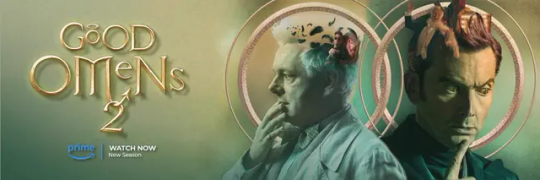


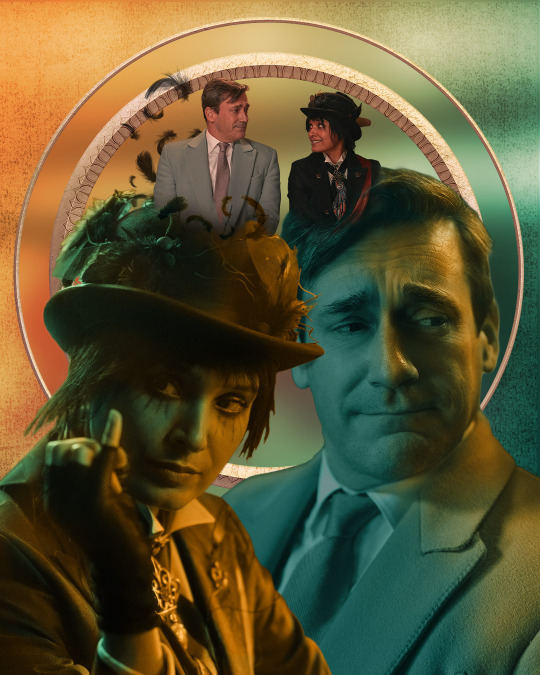
I'm planning on doing individual posts for specific scenes, episodes, and minisodes that require detailed breakdowns. I'll update this list with links as the posts are finished!
POV "Your 'Something's Wrong' Voice"
POV a Trip to Hell and a 25 Lazarii Miracle
POV a Companion to Owls
POV The Dirty Donkey & I think I Found a *Clue*!
POV Bodysnatchers & Cosplaying a bookseller
POV 1941
POV The Ball
POV The End?
Whose POV is it Anyway - a Conclusion
#good omens#good omens 2#michael sheen#david tennant#crowley#aziraphale#good omens meta#crowley x aziraphale#good omens theories#good omens clues#good omens fandom#ineffable husbands#good omens clue#good omens theory#good omens pov#good omens writing#good omens 3#good omens filters#ineffable mystery#ineffable divorce#ineffable spouses#ineffable idiots#ineffable fandom
259 notes
·
View notes
Text
If you missed the ineffable con
You can still buy tickets and access the recorded sessions, including the Peter Anderson, Rory Kurtz, Colin Smythe, and Sandy Higgins interviews. The proceeds all go to Alzheimer's Research, in honor of Terry Pratchett.
You can also sign up for the email list to get notified of the next virtual con.
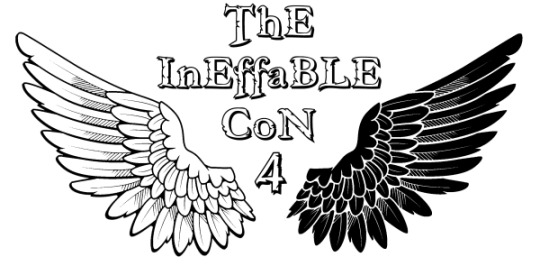
I'm sharing this because I didn't even realize this was going on until the end and could have been at those events live; I was able to catch the Gavin Finney interview and it was so so amazing, and I never want to miss that opportunity again.
17 notes
·
View notes
Text
Interview: Bitcoin Transactions and American Taxation
Bitcoin is a cryptocurrency and worldwide payment system. It is the first decentralized digital currency, as the system works without a central bank or single administrator. The network is peer-to-peer and transactions take place between users directly, without an intermediary. These transactions are verified by network nodes through the use of cryptography and recorded in a public distributed ledger called a blockchain.
Bitcoins are created as a reward for a process known as mining. They can be exchanged for other currencies, products, and services. As of February 2015, over 100,000 merchants and vendors accepted bitcoin as payment.
Research produced by the University of Cambridge estimates that in 2017, there are 2.9 to 5.8 million unique users using a crypto currency wallet, most of them using bitcoin. The word bitcoin first occurred and was defined in the white paper that was published on 31 October 2008.
It is a compound of the words bit and coin. The white paper frequently uses the shorter coin. There is no uniform convention for bitcoin capitalization.
On 18 August 2008, the domain name “bitcoin.org” was registered. In November that year, a link to a paper authored by Satoshi Nakamoto titled Bitcoin.A Peer-to-Peer Electronic Cash System was posted.
Nakamoto implemented the bitcoin software as open source code and released it in January 2009 on SourceForge. The identity of Nakamoto remains unknown. In January 2009, the bitcoin network came into existence after Satoshi Nakamoto mined the first ever block on the chain, known as the genesis block. Embedded in the coinbase of this block was the following text:
The Times 03/Jan/2009 Chancellor on brink of second bailout for banks
This note has been interpreted as both a timestamp of the genesis date and a derisive comment on the instability caused by fractional-reserve banking.
One of the first supporters, adopters, and contributors to bitcoin was the receiver of the first bitcoin transaction, programmer Hal Finney. Finney downloaded the bitcoin software the day it was released, and received 10 bitcoins from Nakamoto in the world’s first bitcoin transaction. Other early supporters were Wei Dai, creator of bitcoin predecessor b-money, and Nick Szabo, creator of bitcoin predecessor bit gold.
In the early days, Nakamoto is estimated to have mined 1 million bitcoins. In 2010, Nakamoto handed the network alert key and control of the Bitcoin Core code repository over to Gavin Andresen, who later became lead developer at the Bitcoin Foundation. Nakamoto subsequently disappeared from any involvement in bitcoin. Andresen stated he then sought to decentralize control, saying:
“So, if I get hit by a bus, it would be clear that the project would go on”
This left opportunity for controversy to develop over the future development path of bitcoin. The value of the first bitcoin transactions were negotiated by individuals on the bitcointalk forums with one notable transaction of 10,000 BTC used to indirectly purchase two pizzas delivered by Papa John’s.
The post Interview: Bitcoin Transactions and American Taxation appeared first on Bitcoin, Ethereum, ICO, Blockchain & Cryptocurrency.
from WordPress https://ift.tt/2Nz0ytK via IFTTT
0 notes
Text
War Nakamoto Japaner?
Der Artikel War Nakamoto Japaner? Bitte sehen Sie weitere Informationen hier: CoinBlatt
Nein, Satoshi Nakamoto ist kein 64-jähriger Japaner, der in Kalifornien lebt, wahrscheinlich … Hal Finney, Michael Weber, Wei Dai und einige andere Entwickler, sind die, die regelmäßig in Medienberichten und Online-Diskussionen als potentielle Satoshis genannt werden. Eine Gruppe forensischer Linguistikexperten von der Aston University glaubt, dass der wahre Schöpfer von Bitcoin Nick Szabo ist, basierend auf der Analyse des Bitcoin White Paper. Dominic Frisby, ein Komiker und Schriftsteller, schlägt auch Szabo als den BitGold-Schöpfer vor. Fuer ihn ist er der wahrscheinlichste Kandidat für Satoshi in seinem Buch “Bitcoin: Die Zukunft des Geldes”. Seine detaillierte Analyse beinhaltete die Linguistik von Satoshi’s Schreiben, wobei er das Niveau der technischen Fähigkeiten in C ++ und sogar Satosis wahrscheinlichen Geburtstag beurteilte. In Nathaniel Poppers Buch “Digitial Gold”, veröffentlicht im Mai 2015, enthüllt Popper, dass Szabo in einer seltenen Begegnung bei einer Veranstaltung wieder leugnete, dass er Satoshi war. Anfang Dezember 2015 behaupteten Berichte von Wired und Gizmodo vorläufig, Nakamoto als australischen Unternehmer Craig S Wright identifiziert zu haben. WIRED zitiert “eine anonyme Quelle in der Nähe von Wright”, die einen Cache von E-Mails, Abschriften und anderen Dokumenten zur Verfügung stellte, die auf Wrights Rolle bei der Erstellung von Bitcoin hinweisen. Gizmodo zitierte einen Cache von Dokumenten, die von jemandem stammen, der behauptete, Wright’s geschäftlichen E-Mail-Account gehackt zu haben, sowie Bemühungen, Personen in seiner Nähe zu befragen. Die Idee, dass die Wright-Satoshi-Verbindung nichts anderes als ein Scherz ist, wurde von Beobachtern verbreitet, obwohl die zwingende Natur der veröffentlichten Beweise zweifellos Spekulationen für eine gewisse Zeit anheizen wird. Zum größten Teil haben alle diese potentiellen Satoshi darauf bestanden, dass sie nicht Nakamoto sind.
Also, was wissen wir von ihm?
Eine Sache, die wir wissen, basiert auf Interviews mit Leuten, die mit ihm in einem frühen Stadium der Entwicklung von Bitcoin beschäftigt waren, dass er das System sehr gründlich durchdachte. Seine Kodierung war laut Kernentwickler Jeff Garzik nicht konventionell , da er nicht die gleichen strengen Tests anwendet, die Sie von einem klassischen Softwareentwickler erwarten würden.
Wie reich ist er?
Eine Analyse von Sergio Lerner, einer Autorität für Bitcoin und Kryptographie, legt nahe, dass Satoshi viele der frühen Blöcke im Bitcoin-Netzwerk abgebaut hat und dass er ein Vermögen von etwa 1 Million nicht ausgegebener Bitcoins aufgebaut hat. Dieser Hort würde im November 2013 einen Wechselkurs von 1.000 Dollar im Wert von 1 Milliarde Dollar haben.
Was macht er jetzt?
Niemand weiß, was Satoshi vorhat, aber eine der letzten E-Mails, die er an einen Software-Entwickler vom April 23 2011 richtete, sagte er: “Ich bin zu anderen Dingen übergegangen. Es ist bei Gavin und allen in guten Händen. ”
Hat er für die Regierung gearbeitet?
Es gibt natürlich Gerüchte. Die Menschen haben seinen Namen als “zentrale Intelligenz” verstanden, aber die Menschen werden sehen, was sie sehen wollen. Das ist die Natur von Verschwörungstheorien. Die naheliegende Frage wäre, warum eine der drei Briefagenturen daran interessiert wäre, eine Kryptowährung zu schaffen, die später als anonymer Handelsmechanismus genutzt werden sollte. Senatoren und das FBI würden sich gleichermaßen über Terrorismus und andere kriminelle Machenschaften streiten. Zweifellos werden auch Verschwörungstheoretiker ihre Ansichten dazu haben. Vielleicht ist es egal. Core-Entwickler Jeff Garzik bringt es auf den Punkt. “Satoshi hat ein Open-Source-System zu einem Zweck veröffentlicht, ohne dass man wissen muss, wer er war, lediglich darauf vertrauen, wer er war und dass er sich um sein Wissen kümmerte”, betont er. Open-Source-Code macht es unmöglich, Geheimnisse zu verstecken. “Der Quellcode hat für sich selbst gesprochen.” Darüber hinaus sei es klug, ein Pseudonym zu verwenden, argumentiert er, weil es die Menschen zwang, sich auf die Technologie selbst und nicht auf die Persönlichkeit dahinter zu konzentrieren. Letztendlich ist Bitcoin jetzt größer als Satoshi Nakamoto. https://coinblatt.de/wer-ist-satoshi-nakamoto/ from COINBLATT - Feed https://coinblatt.de/war-nakamoto-japaner/
0 notes
Text
Pieter Wuille - CoinDesk
http://www.cryptoga.com/news/pieter-wuille-coindesk/
Pieter Wuille - CoinDesk
This is an entry in CoinDesk’s Most Influential in Blockchain 2017 collection.
Pieter Wuille is speedy to bite his tongue.
In a person of the developer’s 1st-ever extensive-sort interviews, it’s crystal clear he has a good deal of views to share. He gets fired up when chatting about bitcoin’s coming innovations and the cryptocurrency’s primary white paper.
“You will find so substantially we have learned considering the fact that then,” he claims, addressing all those he feels handle the 9-page doc, released in 2008, as a “bible” of kinds.
About the span of just a handful of minutes, he lists quite a few holes in the paper – so-identified as “fraud proofs” have been shown not likely, or at the very least quite difficult, to operate, whilst it failed to predict important innovations, these kinds of as scripts and payment channels.
He is likely a person of the handful of proficient sufficient to choose apart bitcoin’s guiding doc. And nevertheless, as he starts off to speculate on how Satoshi Nakamoto’s paper might seem if drafted currently, he stops mid-sentence.
“I genuinely shouldn’t speculate,” Wuille claims.
And when requested what he would do if Nakamoto appeared before him – following a pause – Wuille claims, “I would say, ‘Thank you.'”
In these times of hesitation, these flashes of deliberation, the shy developer decides it is really greater to preserve his concentrate on the specifics than permit his views be applied in the political barrage that bitcoin’s raging scaling debate has become.
These times, they outline Pieter Wuille, along with his six yrs of servitude, doing work tirelessly on Bitcoin Main, the currency’s most well known software program implementation (as very well as the expression normally applied to denote the loose group of volunteers that make improvements to this code).
Following Wladimir van der Laan, bitcoin’s guide maintainer, Wuille has produced the next-most contributions to the software program, but it is really harmless to say he is been powering some of the much more considerable improvements. Just one particular improve, Segregated Witness (SegWit), arrived to outline this year’s scaling debate.
The groundbreaking (and extremely controversial) alter, enacted in August, shook the bitcoin neighborhood this calendar year, where tensions were high and social media was a firestorm of finger-pointing and slander.
You would assume the creator of the code alter would get concerned and defend its creation, but actually Wuille appeared also cool and gathered to stoop to these kinds of levels.
In accordance to developer Nicholas Dorier:
“Pieter is hoping to put aside all politics and generally seem only at the technical aspects of points.”
The puzzle
This is probable why you can perception a cringe when he is requested how substantially bitcoin he owns, and why he claims he couldn’t assume of any truly defining stories around his yrs of doing work on bitcoin. His personal web site is bare, with just a spinning e mail icon whose pixelated graphics seem straight out of the 1990s.
Wuille looks to cherish his privateness.
It would make perception, lots of bitcoin fanatics arrived to the cryptocurrency that way, but becoming a person of the most very well-highly regarded builders, that was anything that only another person as poised and targeted as Wuille could pull off.
But his story commences with yet another personal computer scientist and noteworthy cypherpunk, the late Hal Finney, the receiver of bitcoin’s 1st-ever transaction.
In 2011, Finney – who contrary to other jaded cypherpunks at the time was trying to keep an open up thoughts to bitcoin – submitted a contest (with a 20 bitcoin prize) to a well known bitcoin converse discussion board. A cryptographic puzzle, it was created to check developer knowledge of the nascent currency.
And Wuille rapidly obtained to operate.
This was the 1st time Wuille, who experienced a PhD in personal computer science and a career at Google powering him, appeared around the bitcoin codebase. Like lots of other programmers, Wuille’s interest was piqued on a technical level – originally the code appeared like a mishmash, but he marvelled that bitcoin actually worked (following so lots of failed decentralized cash performs).
And in flip, he put collectively a solution – his 1st shot at bitcoin enhancement, a instant that would alter his life, and the trajectory of bitcoin, without end. However, that wasn’t his shining instant.
“I never try to remember who won, but it wasn’t me,” Wuille claims.
Nevertheless, while some might shrug their shoulders and go on, Wuille remained hooked on bitcoin.
He explained to CoinDesk:
“At the time, when I found out bitcoin, I didn’t expect it would become my career or that I would spend just about every instant of my totally free time on it.”
And he is applied a practically unbreakable concentrate to tune out the trash converse and proceed lumbering alongside towards the upcoming where cryptocurrency improvements the globe.
For him, SegWit was just a person small stage.
Zen Masters publish code
But to get SegWit additional to bitcoin was much more of an uphill climb.
Released in 2015, the code was originally applauded by the neighborhood as major stage for cryptocurrency, largely in that it preset a bug that prevented ahead-searching projects from increasing the technology’s abilities. As a outcome of the alter, tips these kinds of as the Lightning Network and Schnorr signatures are feasible to implement.
At the time, Wuille pitched the notion as a compromise that would appease each sides of bitcoin’s scaling debate – a person which desired sluggish and continual scaling that wouldn’t raise the size of the blockchain, and the other of which desired much more hasty on-chain scaling.
Nevertheless, SegWit turned out to be an unexpectedly controversial alter.
To oversimplify, builders have frequently sided with the “sluggish and continual” tactic to code improvements, while bitcoin providers and miners tended to want greater and quicker scaling, pointing to extensive transaction instances and rising transaction fees as deterrents that would preserve new buyers from using the “digital currency.”
As the debate among all those two teams heated up, Wuille hardly chimed in on the debate raging close to him. Mirroring a Zen Master who’s been through yrs of extreme analyze to access enlightenment, Wuille kept his head down.
And using the mantra “cypherpunks publish code,” Wuille endeared himself to the bitcoin neighborhood, which has regard for all those that code up methods to issues rather than attempt to realize alter by political or social means.
Bystanders to bitcoin’s fiery debates have argued he is also “active creating code” to get concerned in all the drama.
Some go as much as to argue he appreciates bitcoin greater than anybody. Dorier, for instance, claims Wuille has a “around-total knowledge” of all of bitcoin’s supply code. And Bitcoin Main contributor Eric Lombrozo claims Wuille “obsesses” around his coding operate, albeit in a “tranquil” way.
Large coronary heart
However, on the telephone, Wuille admits he has not been equipped to tune the debate out fully.
“It can be been major,” Wuille explained to CoinDesk, sighing. “I have been in the center of it for for a longer period than it is really been public.”
The debate 1st entered the limelight in early 2015, when former Bitcoin Main maintainer Gavin Andresen released a collection of weblog posts advocating for an raise to the 1 MB block size parameter, a technical direction that lots of other builders shunned.
Legitimate to his reserved personality, even though, Wuille wouldn’t identify any names or dive also deep into the details when requested for clarification.
He proceeds, sounding a very little like a forlorn sage, “The complete block size debate started out out amid builders before selected people today introduced it to the public. But that was a extensive time ago.”
And irrespective of owning views on the make a difference, in public he stayed composed – wading into the debate only to make limited technical corrections.
In a person fiery thread, for case in point, rather than point fingers or namecall, Wuille responded to a person technical comment make a difference of factly: “This is improper. The signatures are generally desired when a node 1st procedures a block, regardless of whether that is now or afterwards.”
The teacher
Although, some builders wish he experienced expressed much more of an belief. Consider Lombrozo, a person of the group’s much more public users, who claims he normally ponders regardless of whether it would be greater for Wuille and other shy coders to stage up.
“I’d substantially rather people today listened to people today like Pieter,” he claims.
Social media channels are stuffed with misinformation and falsehoods, he argues, and builders like Wuille, who deeply realize how bitcoin functions, could support to fill the gaps. That reported, Lombrozo’s not pushing also tough.
“It can be just not his personality,” he claims. “He and builders like Van Der Laan shun the highlight and the media in some strategies. It can be outside the house their ease and comfort zone.”
In this way, Purse.io founder and CEO Andrew Lee agrees. Even even though he is personally attempted to back choice software program attempts, he admires Wuille, contacting him much more “self-actualized” than the common human being, which means he appreciates what would make him content in life – coding – and sticks with that.
Lee explained to CoinDesk:
“I assume it is really magnificent that he has stayed out of it. Pieter appreciates where he would like to have an result.”
And that looks to be on other builders. Wuille has a background of passing on guidelines to newer coders, instructing the strategies of the open up-supply bitcoin globe.
Lombrozo notes that when he 1st tried to get into bitcoin enhancement, Wuille took him underneath his wing, instructing him about the tools and procedures. (Lombrozo and Wuille would afterwards buddy up to operate on SegWit collectively).
And Lee claims identical points, pointing to Purse’s Bcoin, a bitcoin code implementation in Javascript, which was a person of the 1st projects to increase SegWit guidance.
“[Integrating SegWit] wouldn’t have been feasible with out Pieter. He is tremendous valuable to all people in the area,” Lee claims.
Quick-expression soothsayer
Beyond all that, Dorier claims Wuille has a sixth perception for bitcoin advancements.
“What’s quite extraordinary is that he is able of figuring out what is likely to occur in the following calendar year and focusing on the operate for the shorter-expression,” he claims.
And if Dorier’s appropriate, signature aggregation, a alter championed by Wuille that mashes signature info collectively permitting much more transaction info to fit into every single block, could be a person of the following bitcoin advancements.
Wuille discovered to CoinDesk that he is creating a much more concrete bitcoin advancement proposal (BIP) for the code alter.
And Dorier, who phone calls the improve “the following major stage,” guesses the alter could be additional to bitcoin in the following few yrs. But why’s Wuille performing all this? What would make the Zen Master spend all his time grinding away at bitcoin? As other builders and crypto-fanatics, he idealizes a upcoming globe with a fully working bitcoin.
“It might conclusion up switching the globe,” Wuille claims, incorporating:
“I assume it can show how technological innovation can take out the have to have for selected third functions and systemic chance that exists in the globe.”
But till then, and in accordance to Wuille we’re much from that, he’ll preserve tinkering away.
For the reason that he thinks, for all the animosity, the scaling debate hit a high point in 2017 mainly because an ecosystem has blossomed close to bitcoin, even even though at a technical level it is really not quite experienced nevertheless.
And that is the a person factor lots of people today fail to realize, he argues.
“Bitcoin’s not prepared for mainstream adoption. There are lots of unsolved issues,” he claims, pointing to privateness and scalability, amid many others.
And he however anxieties that it could all go down in spoil if there issues aren’t solved.
“We have to have to get the incentives appropriate so we never just swap a person banking procedure with yet another,” he claims.
But as a result of it all, bitcoin’s Zen Master leaves us with affected individual optimism like any very good guru would:
“We are going to get there in time.”
Primary artwork by Luis Buenaventura II, creator of the CryptoPop web site. Click on in this article to perspective much more by the artist, and to examine out the official CoinDesk Most Influential T-shirt.
The chief in blockchain news, CoinDesk is an unbiased media outlet that strives for the maximum journalistic criteria and abides by a rigid set of editorial procedures. Intrigued in providing your abilities or insights to our reporting? Get in touch with us at [email protected].
0 notes
Text
December 7, 2017
Ethereum News and Links
Protocol
Tradeoffs in account abstraction
Dec 1st core dev call. Agenda.
This week's Casper standup call
ERC20-K: Formal Executable Specification of ERC20
Alexey Akhunov profiles the Geth client during cryptokitty peak mania.
Vlad Zamfir: Against on-chain governance.
I think everyone already assumed this would be the case, but Vitalik comes out in favor of a carbonvote as a necessary condition to unfreeze Parity multisig Ether.
An ELI5 on Ethereum's scaling projects from Dunning_Krugerrands
Stuff for developers
Solidity v0.4.19 release. Fantastic to see how many contributors there were. It'd be great if more people were working on Solidity fulltime: send your CV to [email protected]
Plus more on the new Solidity ABI Encoder/Decoder and Optimizer
A React HOC for Ethereum
Solidity Eclipse IDE
"countable, iterable and unordered set type for Solidity that stores unique items"
An intro to Ethereum coding from Zeppelin
Beautifying your tests with JavaScript
Aragon and Placeholder are announcing a grants program to build Aragon and Ethereum public goods -- infrastructure and dev tooling
Python + Ethereum email list
uPort hackathon on TopCoder
Zeppelin's Ethernaut game for security in solidity
CryptoKitty mania
How does CryptoKitties work? And a walk through the codebase.
CryptoKitties isn't as decentralized as you think. But if there's a conflict, "the community will just hard fork the kitties."
Jeff Wilcke agrees to buy a gen zero cat from Nick Johnson for ~90k to charity if a tweet got to 500 RTs, but someone nabbed it first
Transactions hit 800k in a day. Metamask grew its user base by 35% in kitty mania week. Per EthGasStation, the current safe low is 55gwei. But just raising the gas limit isn't really an option.
Reminder: if your transaction is stuck in limbo, re-send it with the same nonce and a higher gas price based on Eth Gas Station.
Can't vouch for the veracity, but this claims CryptoKitties is almost 70% of total gas usage.
Kitty explorer and kitty sales. We're currently over 8m USD equivalent transacted, but it seems like Dec 4th was the peak with daily small declines afterward.
Burnable payments to decompile the GeneScience bytecode.
Ecosystem
Etherisc proposes insurable crypto wallet specification
The mechanics of Zug's uPort ID
Cosmos' Ethermint testnet is live
Alex Miller: Building a Usable Multisig Wallet
Chronicled is implementing zk-snarks for pharma provenance
Token Curated Registries 1.1 -- now with slashing
Token curated governance with stake machines
MicroRaiden's main net bug bounty release
Project Updates
Brave is giving away ~$5 in BAT tokens. Free "money" for Brave users to support publishers.
Decentraland's Terraform event starts Dec 15
Status joins the EEA. We're seeing them step up as leaders in order to achieve their goals. Status will also come pre-installed on the Finneyblockchain phone.
Etherisc accepted into the UK's FCA regulatory sandbox. Also: building protocols for decentralized insurance
iExec is giving away 150k in grants to people who build on iExec.
Colony's reputation system
Project Announcements and Whitepapers
Vynos inbrowser payment channel wallet from Spankchain and Machinomy
Earn.com white paper
Zipper blockchain phone
Interviews, Videos and Talks
Joe Lubin's CNBC hit. All substance, no hype. That's the Ethereum spirit.
Polychain's Olaf predicts the Flippening in 2018. He gives great media interviews.
I talk to Jack Spallone about what Ujo Music has been up to and where it's going.
Joe Lubin answers questions about ConsenSys on the Bridge BKpodcast.
Brian Armstrong on Bloomberg TV
Gavin: "The journey to web3" from Melon's M-0 conf
Token Sales
ConsenSys launched the Brooklyn Project to address issues around token sales.
SEC cracked down on another ICO scam from a repeated scammer.
Zenel Batagelj: Towards the next era - ICO 3.0
Messari's transparency goals
Token Sale Projects
The lady doth protest too much: OpenBazaar is now doing an Ethereum token. Joking aside, welcome. Brian Hoffman is hilarious (how does that video have just 200 views?)
Failed Venezuelan dictatorship thinks it can circumvent sanctions by selling a cryptoasset. If they sell any, then we are indeed in a bubble.
General
Vitalik Buterin in Bloomberg's 50 Most Influential People of 2017
Mike Bloomberg actually (!) said this: "the Bloomberg system is a blockchain, instead of having the users control it, we control it."
Chris Padovano: Decentralized exchanges aren't above the law
Yahoo Finance integrated 100+ blockchain assets. Very random selection.
Nathaniel Popper visits Coinbase and writes about it for the New York Times.
Dates of note
From Token Sale Calendar.
Upcoming token sale start dates:
December 8 – SingularityNet
December 10 – Gazecoin
December 11 – Aurora DAO from IDEX
December 23 – Rocketpool (proportional refund cap, started November 25h)
Ongoing token sales:
Neufund ICBM
Debitum
Nous Platform
Bloom
Relest
CanYa
Realisto
FundRequest
Dopameme
Gizer
Aigang
Hirematch
ScriptDrop
SeedsTokens
WARNING: list may include or even likely includes scams and quasi-scams. Do your own research and due diligence before putting value at risk
[I aim for a relatively comprehensive list of Ethereum sales, but make no warranty as to even whether they are legit; as such, I thus likewise warrant nothing about whether any will produce a satisfactory return. I have passed the CFA exams, but this is not investment advice. If you're interested in what I do, you can find my somewhat out-of-date investing thesis and token sale appreciation strategies in previous newsletters.]
If you appreciate this newsletter, thank ConsenSys
I'm thankful that ConsenSys has brought me on as an employee and given me time to do this newsletter.
My charge from Joe Lubin is pretty similar to what Status has told me: keep telling the truth and covering the space as objectively as I can.

Editorial control is 100% me. Blame me first and last.
Social
Follow me on Twitter? @evan_van_ness
This newsletter is supported by ConsenSys (surely you have seen that we're hiring?) and Status.im. Many thanks to both.
Sign up to receive the weekly email.
0 notes
Text
Elon Musk: I Am Not Bitcoin Inventor Satoshi Nakamoto
The debate on the identity of Satoshi Nakamoto promises to be a never-ending one. After a former SpaceX intern blogged that Elon Musk is probably Satoshi, Musk clarified that he is in fact not the creator of Bitcoin.
Rumour mills start rolling
People have speculated about Satoshi’s origins ever since Bitcoin was invented. The trigger to get the rumour mills rolling this time was a blog post by Sahil Gupta, former intern at SpaceX, who blogged that Elon Musk was probably Satoshi Nakamoto. Sahil uses Elon Musk’s background in Economics, experience in production level software and history of innovation to speculate that Elon Musk ‘probably’ invented Bitcoin. Given the divisive nature of the blocksize debate in the Bitcoin community, Sahil sought Elon’s (or Satoshi’s) intervention and asks him to play the role of a founding father (similar to Vitalik Buterin in Ethereum).
Outright denial
Elon Musk, has however, denied that he was Satoshi Nakamoto and going on to add that he had lost the Bitcoins which were sent to him a few years back.
Elon Musk tweeted
If This Is True Once Again @elonmusk https://t.co/HfGP8Dz5Oi
— Ѕαи∂єєρ Gυттιкσи∂α (@ThisIsSandeepG) November 28, 2017
There has been chatter on social media in the past about whether Elon Musk could be Satoshi, but nothing ever came of the talk. Musk’s earlier stated views on Bitcoin were not flattering. In an earlier interview, Elon Musk had said:
“I guess it is primarily going to be a means of doing illegal transactions. That is not necessarily entirely bad. Maybe some things shouldn’t be illegal…. You should have a legal to illegal bridge.”
The Nakamoto and Craig Wright fiascos
Previous hunts for Satoshi Nakamoto have not ended well. Craig Wright claimed in 2016 that he was Satoshi and managed to convince a few mainstream media organizations and Bitcoin developer Gavin Andresen, before his claim was debunked.
In 2014, Newsweek’s cover story claimed that the magazine had uncovered the identity of Satoshi. They speculated that an engineer named Dorian Nakamoto was actually the creator of Bitcoin. A media frenzy followed, despite Dorian Nakamoto’s repeated denials that he wasn’t Satoshi. Eventually the Newsweek story was debunked, the magazine was left with egg on its face and Dorian Nakamoto’s life was turned completely upside down, bringing great financial hardship to the man.
Various people from Hal Finney to Nick Szabo were thought to have been Satoshi at various points in time, but nobody knows for sure. Many still believe that Satoshi is actually a group of people rather than a single individual.
Does it really matter?
While Bitcoin has grown organically and drawn millions of users into its fold without the active involvement of Satohi, questions will always remain about his identity. Nonetheless, the development of the Bitcoin protocol has proceeded apace without Satoshi, given the talented developers who work on Bitcoin and significant community support.
However, if Satoshi is still alive and if he still holds his private keys, he is believed to own about one million Bitcoins. With Bitcoin having just breached the $10,000 level, that gives Satoshi a net worth, on paper, of $10 bln. Given that many believe Satoshi no longer has control over the coins, if he ever decided to sell his Bitcoins, the price of Bitcoins might plunge.
Given that Satoshi has remained out of the limelight for so long, it does seem likely that he values his privacy more than the billions that his Bitcoins are worth. Then again, with Bitcoin’s epic bull run, nobody knows at what point the mysterious founder might change his mind.
Source Cointelegraph
Follow us on Facebook
The post Elon Musk: I Am Not Bitcoin Inventor Satoshi Nakamoto appeared first on Entrepreneur.
via Kingmind Elon Musk: I Am Not Bitcoin Inventor Satoshi Nakamoto
0 notes
Link
EPISODE 1
By the time Gaiman and director Douglas Mackinnon had finished cutting together Episode 1, it was about 75 minutes long, “which meant that we needed to lose 20 minutes,” Gaiman said. “And that 20 minutes was really hard to lose, because it was 20 minutes of beautiful material.”
Among those cut minutes was an extended scene of Crowley disabling the London mobile phone system, as he later reports to the demons in the graveyard during his evil deeds-of-the-day rundown.
“We built a huge set in South Africa for the BT Tower,” production manager Michael Ralph said. Crowley enters the lobby and tells the security guard he’s been sent from Rataway Pest Control to do a preliminary inspection. He’s taken up to the top floor, which is infested with hundreds of rats — rats summoned to do the demon’s bidding. (The rats were animated.) Crowley walks over to the computer room and tips tea from a thermos into the network controller, which makes the lights flicker and go out. Mission accomplished!
The scene then included people on the city streets experiencing the interruption in their mobile service at the worst possible moments (when they need to close a deal, arrange a pickup, or stave off a breakup), and Crowley walks away smiling. “We shot the whole thing, including helicopter arrivals to the BT Tower,” Ralph said. “There was a massive amount of work involved there,” cinematographer Gavin Finney agreed.
“What we wound up doing as our solution to bringing Episode 1 into focus was throwing out anything that was not directly part of the story,” Gaiman said. “We wound up with something that’s incredibly fast-moving and feels very full, but also runs just a hair over 50 minutes.”
EPISODE 3
The most elaborate sequence — a 30-minute cold open — is not based on anything from the book per se. “It’s an exploration of the characters that [are] in the book in its heart,” Mackinnon said, “but it needed to be externalized. It needed to be shown.”
The trick was that it was rather expensive to cover about 6,000 years of history, with different looks and locations, and the production had to get creative to keep it viable. The spot in South Africa used for Noah’s ark in Mesopotamia in 3004 B.C. is the same location used for the crucifixion in Golgotha in 33 A.D. — just from a different angle. The crucifixes, Ralph noted, were the hardest part; he had to make them oversized so they would have an impact on camera, and he used a river of red cloth on the ground to suggest an abstract river of blood. Ancient Rome in 41 A.D. was built in the same studio later used to double for a dungeon during the French Revolution in 1793.
A location scout for the camp for the kids’ playground gave the production the idea of where to stage Arthurian Britain in 537 A.D. — a valley in Surrey where a castle turret was visible. “I thought, ‘Wouldn’t that be fantastic in the mist?’” Ralph said. “We didn’t need to build anything. We only needed to add the fog.”
“A ridiculous amount of fog,” Finney agreed. “We were just riffing on ideas from Excalibur and Monty Python there.”
The next period of history, Shakespearean London in 1601, brought a bit of luck — Good Omens got to be the first fictional production to shoot inside the Globe Theatre. The catch was that they could only shoot for five hours, which wasn’t enough time to manage a shoot with 500 extras in period costume. The solution? Turn a full Globe Theatre into an empty one, and make Shakespeare's play a flop. (“It’s funnier,” Gaiman said.)
Revolutionary France brought its own set of difficulties. Ralph researched how to make a working guillotine, and had the perfect spot to set it up – at the University of Cape Town, which was filled with architecture reminiscent of 1793 France. “I was going to build a platform and have hot water washing the blood down and steam coming up,” the production designer said. “But we ran out of time to do it before the university opened.” They came up with the solution to hear the guillotine outside a dungeon cell (built in the studio) instead.
Somewhere within this sequence — perhaps after Shakespearean England but before Revolutionary France — was supposed to be one more time capsule: Aziraphale opening his bookshop for the first time. Gabriel shows up to tell Aziraphale that he’s been promoted and can go back to Heaven, but Aziraphale doesn’t want to go. Crowley turns up with chocolate and flowers to congratulate Aziraphale, and overhears the conversation, so he instead turns around and sets up something where Aziraphale needs to intervene, to prove to Gabriel that Aziraphale’s appearance on earth is vital. “It was really funny,” Gaiman said. But his justification for taking it out was that it didn’t push the story forward as much as the other moments did.
#good omens#good omens spoilers#neil gaiman#michael ralph#douglas mackinnon#gavin finney#deleted scenes#interview#bts#fun fact#I miss that opening bookshop scene :(#at least they filmed the one from ep1#so perhaps dvd?
2K notes
·
View notes
Text
How Money Got Free: Bitcoin and the Fight for the Future of Finance
How Money Got Free: Bitcoin and the Fight for the Future of Finance
Reviews
Brian Patrick Eha’s definitive history, How Money Got Free: Bitcoin and the Fight for the Future of Finance (Oneworld, 2017), goes a long way in answering questions on what Bitcoin is, explaining its origins and detailing how this all happened.
Also read: Introduction To “The Satoshi Revolution” – New Book by Wendy McElroy Exclusively on Bitcoin.com
Bitcoin is a Drama Unfolding in Our Time
Podcast host Joey Clark of the Joey Clark Radio Hour, in an archived version of his terrestrial broadcast from an FM, Montgomery, Alabama station, during an interview presented Brian Patrick Eha’s (rhymes with yee-haw) prose as cinematic. Movie-like.
My second full reading confirms as much.
The go-to early history of Bitcoin often cites Digital Gold, Nathaniel Popper’s bestseller from last year now in paper. This is no doubt due to Mr. Popper’s New York Times platform as much as anything else.
And while Mr. Popper’s account is fun and entertaining, he presents Bitcoin and its nascent community as curiosities, and readers are often outside looking-in. There’s a place for that — everyone knows characters within the ecosystem. Bitcoin, even now hovering at its 6K price, is an eccentric idea.
Mr. Eha, on the other hand, doesn’t wallow in the weird. He catalogues strange, for sure, and notes the goofs and creeps, but quickly moves his arc to meat, substance. There is real there-there in Bitcoin as a network and concept, bitcoin as a currency.
Nearly a half dozen names familiar to readers round out Mr. Eha’s 450+ page page-turner (thankfully with copious notes and an index): Gavin Andersen, Hal Finney, Roger Ver, Charlie Shrem, Erik Vorhees, Ira Miller, Nic Cary, Barry Silbert, Amir Taaki, Ross Ulbricht, Cody Wilson.
Four Who Moved the Financial World
To settle-in after some technical discussion, Mr. Eha plucks four Bitcoin players from the above. It’s a nice number, and he’s able to give Barry Silbert, Nic Cary, Roger Ver, and Charlie Shrem the space each deserves. All of them born in the US, white, male, and under 40 years of age. Though that’s not ever really a point of the book, and just something I recently noticed myself, means readers get a peek into a seemingly homogeneous world surprisingly varied and diverse.
Backgrounds of Christian fundamentalism, best and brightest type environments, to wanderers, bleeding hearts, and a raised-observant Jew struggling to break from parental control, help readers not Bitcoin-centric get a feeling for what types of personalities are drawn to these ideas.
We follow the men through their first-mover positions in the space, travel along as bitcoin hits some growing pains, and each of their lives appears to dip and rise like the price itself, only to, of course, rise again.
Mr. Silbert remains a force to mainstream, Wall Street bitcoin. Mr. Carey plugs away at his philanthropy. Mr. Ver is as obstinate and visionary as ever. Mr. Shrem, well, his story might be the most compelling on a human level.
Without giving too much away, Charlie Shrem is our canary in a real-world mineshaft, a one man warning wrapped in a morality play. He’s still not even 30 years old as of this writing, and so there is going to be much added to his saga. But those heady years make for great reading either as an initiation or remembrance.
Lastly, patronize Oneworld Publishing, won’t you? Show the independent London house its gamble to respect our community pays. My feeling is an across-the-pond broker, where long expository writing is valued, is really the only publisher around who would allow so much fine-tuned detail as How Money Got Free demands.
If we want more, we’re going to have to support such risks.
What recent books on bitcoin do you recommend? Tell us in the comments below!
Images courtesy of: WallpapersHD, Bitinstant, Oneworld.
At Bitcoin.com there’s a bunch of free helpful services. For instance, check out our Tools page!
Original Source
http://ift.tt/2ie6j28
0 notes
Text
How Money Got Free: Bitcoin and the Fight for the Future of Finance Brian Patrick Eha’s definitive history, How Money Got Free: Bitcoin and the Fight for the Future of Finance (Oneworld, 2017), goes a long way in answering questions on what Bitcoin is, explaining its origins and detailing how this all happened. Also read: Introduction To “The Satoshi Revolution” – New Book by Wendy McElroy Exclusively on Bitcoin.com Bitcoin is a Drama Unfolding in Our Time Podcast host Joey Clark of the Joey Clark Radio Hour, in an archived version of his terrestrial broadcast from an FM, Montgomery, Alabama station, during an interview presented Brian Patrick Eha’s (rhymes with yee-haw) prose as cinematic. Movie-like. My second full reading confirms as much. The go-to early history of Bitcoin often cites Digital Gold, Nathaniel Popper’s bestseller from last year now in paper. This is no doubt due to Mr. Popper’s New York Times platform as much as anything else. And while Mr. Popper’s account is fun and entertaining, he presents Bitcoin and its nascent community as curiosities, and readers are often outside looking-in. There’s a place for that — everyone knows characters within the ecosystem. Bitcoin, even now hovering at its 6K price, is an eccentric idea. Mr. Eha, on the other hand, doesn’t wallow in the weird. He catalogues strange, for sure, and notes the goofs and creeps, but quickly moves his arc to meat, substance. There is real there-there in Bitcoin as a network and concept, bitcoin as a currency. Nearly a half dozen names familiar to readers round out Mr. Eha’s 450+ page page-turner (thankfully with copious notes and an index): Gavin Andersen, Hal Finney, Roger Ver, Charlie Shrem, Erik Vorhees, Ira Miller, Nic Cary, Barry Silbert, Amir Taaki, Ross Ulbricht, Cody Wilson. Four Who Moved the Financial World To settle-in after some technical discussion, Mr. Eha plucks four Bitcoin players from the above. It’s a nice number, and he’s able to give Barry Silbert, Nic Cary, Roger Ver, and Charlie Shrem the space each deserves. All of them born in the US, white, male, and under 40 years of age. Though that’s not ever really a point of the book, and just something I recently noticed myself, means readers get a peek into a seemingly homogeneous world surprisingly varied and diverse. Backgrounds of Christian fundamentalism, best and brightest type environments, to wanderers, bleeding hearts, and a raised-observant Jew struggling to break from parental control, help readers not Bitcoin-centric get a feeling for what types of personalities are drawn to these ideas. We follow the men through their first-mover positions in the space, travel along as bitcoin hits some growing pains, and each of their lives appears to dip and rise like the price itself, only to, of course, rise again. Mr. Silbert remains a force to mainstream, Wall Street bitcoin. Mr. Carey plugs away at his philanthropy. Mr. Ver is as obstinate and visionary as ever. Mr. Shrem, well, his story might be the most compelling on a human level. Without giving too much away, Charlie Shrem is our canary in a real-world mineshaft, a one man warning wrapped in a morality play. He’s still not even 30 years old as of this writing, and so there is going to be much added to his saga. But those heady years make for great reading either as an initiation or remembrance. Lastly, patronize Oneworld Publishing, won’t you? Show the independent London house its gamble to respect our community pays. My feeling is an across-the-pond broker, where long expository writing is valued, is really the only publisher around who would allow so much fine-tuned detail as How Money Got Free demands. If we want more, we’re going to have to support such risks. What recent books on bitcoin do you recommend? Tell us in the comments below! Images courtesy of: WallpapersHD, Bitinstant, Oneworld. At Bitcoin.com there’s a bunch of free helpful services. For instance, check out our Tools page! The post How Money Got Free: Bitcoin and the Fight for the Future of Finance appeared first on Bitcoin News. https://news.bitcoin.com/how-money-got-free-bitcoin-and-the-fight-for-the-future-of-finance/ To get started: http://bit.ly/unlibitcoin To double its value: http://bit.ly/btc-gold
from Earn Bitcoin Philippines http://www.facebook.com/pages/p/134403977174420 via Rodrigo M. Palacio Tumblr
0 notes
Link
A nice interview with some of the creators :).
#good omens#douglas mackinnon#lourdes faberes#suzanne smith#claire anderson#gavin finney#jenna powell#interview#bts
92 notes
·
View notes
Photo



Interview with Gavin Finney about Cinematography of Good Omen in the Definition magazine
"Each era had a different design treatment, obviously in the case of costume and production design, but also in the way in which they were lit. Neil had always imagined the scene in the church during the Blitz to be an homage to the film noir style of that time.
"Ancient rome was given the patina of an Alma-Tadema oil painting; Elizabethean London was shot in Shakespeare's Globe Theathre; and the 1960s were shot in our Soho set, which was redressed with posters from that time. We also changed the lightning so that it used more neon and bare bulbs for the signage," says Finney.
Gaiman wanted Heaven and Hell to feel like two parts of the same celestial building so Heaven occupied the best penthouse offices, and Hell was stuck in a damp, mouldy basement down below, where nothing works properly.
70 notes
·
View notes